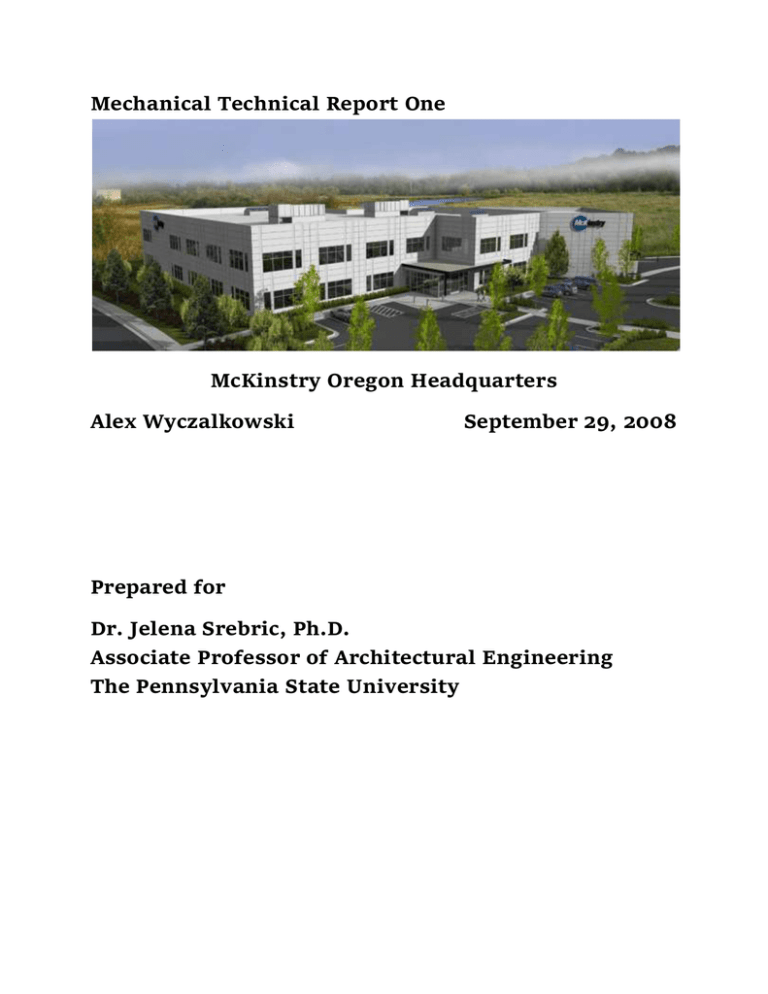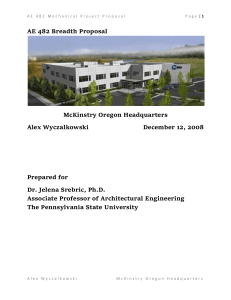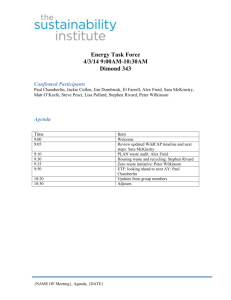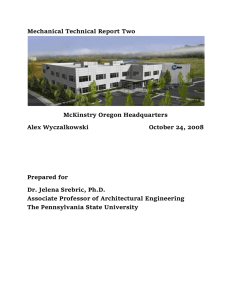Tech Report 1
advertisement

Mechanical Technical Report One McKinstry Oregon Headquarters Alex Wyczalkowski September 29, 2008 Prepared for Dr. Jelena Srebric, Ph.D. Associate Professor of Architectural Engineering The Pennsylvania State University Technical Report 1 Page |2 Table of Contents Executive Summary Page 3 Building and Mechanical System Overview Page 4 ASHRAE 62.1 Section 5 Compliance Page 5 Ventilation Rate Calculation Procedure Page 6 ASHRAE 90.1 Compliance Page 7 Discussion of Results and Solutions Proposal Page 9 References Page 10 Appendix A – Definitions Page 11 Appendix B – Ventilation Rate Procedure Page 12 Appendix C Page 14 Alex Wyczalkowski McKinstry Oregon Headquarters Technical Report 1 Page |3 Executive Summary McKinstry Oregon Headquarters is a 50,590 square foot, 2 story office building. It began construction in March 2008 and is scheduled for completion in March 2009. It is located in Northeast Portland, overlooking the Columbia River. The building contains 2 floors of offices, as well as a full kitchen, showers, and a small weight room for employees. There is also a large warehouse at the west end of the building which is not ventilated. ASHRAE Standard 62.1 – 2007 sets forth guidelines “to provide indoor air quality that is acceptable to human occupants and that minimizes adverse health effects.” Section 5 contains requirements for systems and equipment. After analyzing all systems in the building, no issues were found. Mold growth is adequately addressed, as well as quality if outdoor supply air. Section 6 provides the Ventilation Rate Calculation Procedure. The results found a minimum outdoor air of 5,109 CFM, or 14% outdoor air. This is less than the air handling unit’s minimum outdoor air supply of 5,500 CFM. In summary, McKinstry Oregon Headquarters complies fully with ASHRAE Section 62.1 – 2007. ASHRAE Standard 90.1 – 2007 attempts to ensure energy efficiency in a building by assigning minimum requirements on building systems such as the envelope, HVAC systems, service water heating, lighting, and motors. Several issues were found with the building envelope. Specifically, the roof and walls are under-insulated, as they were constructed according to the 2004 version of Standard 90.1. The slab on grade floor may also be under-insulated. All other areas of Standard 90.1 – 2007 were adequately addressed. In summary, McKinstry Oregon Headquarters should increase insulation in the roof and walls to comply fully with ASHRAE Section 90.1 – 2007. Alex Wyczalkowski McKinstry Oregon Headquarters Technical Report 1 Page |4 Building and Mechanical System Overview McKinstry Oregon Headquarters is a $15.5 million project which is scheduled for completion March 1, 2009. This includes two buildings. The only building of interest is the office building, as the other is simply a warehouse. Costs for the 50,590 square foot office building total $11.1 million dollars. The headquarters is a 2 story office building. The office is laid out in a simple rectangular grid. At the West end of the building a 1 story warehouse attaches at a rotated angle. The flat, tilt-up concrete walls have vertical and horizontal lines to break the long straight façade. Approximately 30% of the office façade is glazing and windows are double glazed. The base of the building is a reinforced concrete slab (there is no basement). The exterior walls are backed by 3-5/8” metal studs and 3.5” batt insulation. A built-up roof with 3” rigid insulation and 1.5” metal decking tops off the structure. The roof also has several translucent skylights for natural day lighting. The remaining lighting in the building is fairly standard with 100% fluorescent fixtures. The central plant of the building is a heat recovery chiller that is used for both heating and cooling. The mechanical system also includes an open loop ground source heat pump. Ground water accepts heat from the condensing water in cooling mode and provides heat to the evaporator water in heating mode. Evaporator side water and condenser side water are piped to the cooling and heating coils in the air handling unit, respectively. A single rooftop AHU (with VFD) distributes air via ducts to the office section of the building. Series VAV boxes with hot water reheats are located throughout the office. Also, an airside economizer can provide cooling on light load days. Two hot water unit heaters keep the warehouse warm in the winter. Heating is provided by the hot water loop and there is no cooling or ventilation. Linear diffusers condition the vestibule at the front of the building. The electric room has a ductless split system ACU for additional cooling. Alex Wyczalkowski McKinstry Oregon Headquarters Technical Report 1 Page |5 Standard 62.1 Section 5 Compliance Several important issues are addressed in Section 5 which must be adhered to in building construction. Factors such as mold growth, reentry of contaminated air, and particulate filtration must all be looked at in a building’s design. Mold growth typically occurs in areas where moisture forms. In the McKinstry headquarters, this can occur in several places. First, condensation may occur at the cooling coils of the air handler. The rooftop unit is equipped with drain pans to address this. The supply air out of the coil is 52.3°F. Since summer indoor air conditions are 74°F and 50% RH (dew point =54°F), condensation on the ductwork is a concern. To address this, the ducts are covered with insulation (minimum R-1.9). Infiltration is also a concern for moisture deposits. However, in Portland, OR, the 0.4% design dew point is 62.5°F. This is significantly lower than the summer design indoor dry bulb of 74°F. Therefore, pressurization of the building is not necessary. The rooftop AHU pulls air near rooftop exhaust vents. Section 5 requires air intake separation distance from “significantly contaminated exhaust” to be at least 15 feet (Table 5-1). The 2 closest exhaust vents are 16’ (data room) and 17’ (restroom) from the intake of the AHU. In addition of contaminants, air is required to be filtered for particulates. The AHU contains a bird screen to proctect from large objects, a 35% efficient prefilter (MERV-8) and 80% efficient secondary filter (MERV-13). Throughout most of the building, the air is listed as Air Class 1: “Air with low contaminant concentration”, meaning that it is acceptable to redistribute the air throughout the building. However, the break room contains a residential style kitchen with hood vents. This air would be considered Air Class 3 and cannot be redistributed into the building. Alex Wyczalkowski McKinstry Oregon Headquarters Technical Report 1 Page |6 Ventilation Rate Calculation Procedure To ensure adequate fresh outdoor air throughout the building, ASHRAE requires designers to follow the Ventilation Rate Calculation Procedure. This procedure is laid out in section 6 of Standard 62.1. Each zone in the building must be calculated separately. McKinstry Oregon HQ has 70 zones. The first and second floors are assumed to be redundant, excluding the vestibule and warehouse. For each zone, breathing zone outdoor airflow is first calculated. This uses the following equation (see Appendix A for definitions): Vbz = RpPz + RaAz Next, zone outdoor airflow is calculated using the equation: Voz = Vbz/Ez To get total outdoor air for the entire building, the procedure uses the equation: Vou = (Ps/∑Pz)*∑RpPz + ∑RaAz Finally your outdoor air intake is calculated with the equation: Vot = Vou/Ev Where Ev is found on Table 6-3, based on: Zp = Voz/Vpz An allowance for short term conditions is included in the procedure. The equation T=3v/Vbz allows the outdoor air requirement to be reduced for peak occupancy occurring for less than the time T in minutes. At McKinstry, T = 91 minutes for the conference rooms. Since many meetings may last up to two hours, short term allowance cannot be used in this case. The full ventilation rate procedure is located in Appendix B. Alex Wyczalkowski McKinstry Oregon Headquarters Technical Report 1 Page |7 Standard 90.1 Compliance Evaluation ASHRAE Standard 90.1 attempts to ensure energy efficiency in a building by assigning minimum requirements on building systems such as the envelope, HVAC systems, service water heating, lighting, and motors. The following table shows envelope code requirements and actual values at McKinstry. Numbers in red indicate possible issues with code compliance Envelope: code versus actual 1 U (max)-code .048 .104 R (min)-code 20 c.i.2 9.5 c.i. U-actual .04 .126 R-actual 18 c.i. 13 Roof Walls3 Floors4 Slab on grade5 F=.730 uninsulated Opaque Doors .700 16 gauge steel w/ 1-¾” polyurethane Windows .4 SHGC (max) =.4 .29 SHGC (max) =.38 Skylights6 1.17 .39 2 layers ¼” glass w/ ½” air gap *All code information from table 5.5-4 (climate zone 4-C) 1 Roof – insulation is entirely above deck 2 c.i. – continuous insulation 3 Walls – Mass (concrete walls backed with metal framing; incontinuous insulation 4 Slab on grade floors – unheated; 5 Glazing – Nonmetal framing (most conservative guess) 6 Skylights – Glass, with curb, 4% of roof Alex Wyczalkowski McKinstry Oregon Headquarters Technical Report 1 Page |8 The following table lists code requirements and actual conditions at McKinstry for the HVAC system, hot water, lighting, power, and pumps. HVAC, hot water, lighting, power, pumps: code versus actual 1 Economizer Economizer Control Type2 Air Handling Unit3 Air Conditioning Unit (Split System)4 Groundwater Source Heat Pump (cooling)5 Groundwater Source Heat Pump (heating)5 Duct Insulation6 DHW Pipe Insulation7 DHW Heater8 Lighting9 Power10 Code Required for >65,000 BTU/h Table 6.5.1.1.3A hp ≤ CFM*.0015 35,800*.0015 = 57.75 hp SEER ≥ 13.0 Actual Yes Fixed Dry bulb hp = 50 EER ≥ 16.2 EER = 21 COP ≥ 3.6 COP = 4.1 SEER = 16.0 No Requirement min R=1.9 for supply ducts min .5” (for pipes ≤1.5”) Efficiency ≥ 80% Efficiency = 95% ≤1.0 W/sf 1.0 W/sf 2% max voltage drop across feeder conductors Pumps11 All pump efficiencies are listed on schedule as being equivalent to Oregon Structural Specialty Code, which uses the same table as ASHRAE 90.1 (Table 10.8). see appendix C 1 Required for all systems >65,000 BTU/h in climate zone 4C (Table 6.5.1) 2 Type is acceptable for Climate Zone 4C(table 6.5.1.1.3A) 3 VFD AHU, must be <CFM*.0015: 35800*.0015= 57.75hp (Table 6.5.3.1.1a) 4 Table 6.8.1A 5 Table 6.8.1B 6 Table 6.8.2 7 Table 6.8.3 8 Gas storage water heater, >75,000btu/h (Table 7.8) 9 Office (Table 9.5.1) Alex Wyczalkowski McKinstry Oregon Headquarters Technical Report 1 Page |9 Discussion of Results and Solutions Proposal McKinstry Oregon Headquarters complied completely with Standard 62.1 section 5. As stated before, mold growth is addressed adequately with drain pans and insulation on supply ducts. Exhaust vents are adequately far from air intake, and filters provide filtration for the air. Hood exhaust from the kitchen is not recirculated into the building. The Ventilation Rate Procedure produced a minimum outdoor air of 6711 CFM. This is approximately 14% of the total supply CFM of 35,800. According to the air handler schedule, minimum outside air is listed as 5500 CFM. So the building complies with ASHRAE Ventilation Procedure. No short term condition reduction could be used in conference rooms. During the Standard 90.1 compliance, a few issues appeared in the envelope construction. The envelope was built in compliance to Standard 90.1 - 2004. Since then, requirements for insulation have gone up, explaining the lower insulation in the roof. Insulation in the walls is greater than required, but is not continuous. There were no issues in compliance with HVAC equipment, hot water, lighting, power, or pumps. The size of DHW pipe insulation was not found. Also, voltage drops across feeder conductors was not calculated, however designers assured that this requirement was adhered to. Based on the findings in this report, the envelope insulation should be improved to comply with standard 90.1 - 2007. Insulation in the roof should be thickened by ½”, to bring the R-value above 20. Also, insulation in the walls should be made continuous. Currently, the tilt-up wall and metal studs create a short circuit in the wall insulation. Alex Wyczalkowski McKinstry Oregon Headquarters Technical Report 1 P a g e | 10 References ASHRAE. 2007, ANSI/ASHRAE, Standard62.1 – 2007, Ventilation for Acceptable Indoor Air Quality. American Society of Heating Refrigeration and Air Conditioning Engineers, Inc., Atlanta, GA. 2007 McKinstry. 2008. Design Documents. McKinstry, Seattle, WA. 2008 Wozniak, Aaron. 2008. Personal Communication. Portland, OR. 2008 Alex Wyczalkowski McKinstry Oregon Headquarters Technical Report 1 P a g e | 11 Appendix A - Definitions Vbz – breathing zone outdoor airflow Rp – outdoor airflow rate required per person (see Table 6-1, Standard 62.1) = 5 CFM/person Pz – zone population Ra – outdoor airflow rate required per unit area (see Table 6-1) = .06 CFM/sf Az – zone floor area Voz – zone outdoor airflow Ez – zone air distribution effectiveness (see Table 6-2) = .8 Vou – uncorrected outdoor air intake Ps – system population = 284 persons (from design documents) Ev – system ventilation efficiency (see Table 6-3) = .8 Zp – zone primary outdoor air fraction Vpz – zone primary airfow T – averaging time period v – space volume Alex Wyczalkowski McKinstry Oregon Headquarters Technical Report 1 P a g e | 12 Appendix B – Ventilation Rate Calculations Zone Notes Area (Az) PopulationRp (Pz) x Pz Ra x Az Vbz Voz Zp Ev 1 Perimeter 742 7.4 37.1 44.5 81.6 102.0 2 Corner 144 1.4 7.2 8.6 15.8 19.8 3 Perimeter 1072 10.7 53.6 64.3 117.9 147.4 4 Stairwell 220 2.2 11 13.2 24.2 30.3 5 Perimeter 172 1.7 8.6 10.3 18.9 23.7 6 Perimeter 413 4.1 20.7 24.8 45.4 56.8 7 Perimeter 471 4.7 23.6 28.3 51.8 64.8 8 Corner 144 1.4 7.2 8.6 15.8 19.8 9 Perimeter 653 6.5 32.7 39.2 71.8 89.8 10 Conference 398 26.5 132.7 23.9 156.5 195.7 0.399 11 Office 2132 21.3 106.6 127.9 234.5 293.2 * Vpz=490 12 Office 5142 51.4 257.1 308.5 565.6 707.0 13 Restroom 493 4.9 24.7 29.6 54.2 67.8 14 Reception 1141 11.4 57.1 68.5 125.5 156.9 15 Lobby 594 5.9 29.7 35.6 65.3 81.7 16 Janitor 50 0.5 2.5 3 5.5 6.9 17 Stairwell 400 0 0 24 24 30.0 18 Office 115 1.2 5.75 6.9 12.65 15.8 19 Office 115 1.2 5.75 6.9 12.65 15.8 20 Mail Room 300 3.0 15 18 33 41.3 21 Waiting Room 596 6.0 29.8 35.8 65.6 82.0 22 Soft Area 596 6.0 29.8 35.8 65.6 82.0 23 Break Room 568 37.9 189.3 34.1 223.4 279.3 24 Stairwell 691 0 0.0 41.5 41.5 51.8 25 Storage 129 0 0 7.7 7.7 9.7 26 Bathroom 710 0 0.0 42.6 42.6 53.3 Alex Wyczalkowski McKinstry Oregon Headquarters 0.8 Technical Report 1 P a g e | 13 Appendix B – continued 27 Open Office 897 9.0 28 Conference 117 7.8 29 Office 117 1.2 30 Office 121 1.2 31 Work Room 118 1.2 32 Elevator 51 0 33 Electrical 262 0 34 Open Office 2111 21.1 35 Vestibule 461 4.6 36 Warehouse *NOT VENTILATED Total for building 44451 522.4 *Cells 1-34 redundant for 2nd Floor *Rp=5, Ra=.06, from table 6-1 *Vbz = Rp*Pz + Ra*Az *Voz=Vbz/Ez, where Ez=.8 Zp = Voz/Vpz, where Vpz is total CFM *Ev - from table 6-3 Ps= system population, 284 Alex Wyczalkowski 44.9 39 5.85 6.05 5.9 0 0.0 105.6 23.1 53.8 7.0 7.0 7.3 7.1 3.1 15.7 126.7 27.7 98.7 46.0 12.9 13.3 13.0 3.1 15.7 232.2 50.7 2612 2667 5279 123.3 57.5 0.246536 16.1 *Vpz=700/3 16.6 16.2 3.8 19.7 290.3 63.4 6598.8 Ps/∑Pz= 0.544 Vou=(Ps/∑Pz)*(∑Rp*Pz) + (∑Ra*Az)= 4087 Vot=Vou/Ev= %OA= 5109 14.3% McKinstry Oregon Headquarters Technical Report 1 P a g e | 14 Appendix C Alex Wyczalkowski McKinstry Oregon Headquarters




